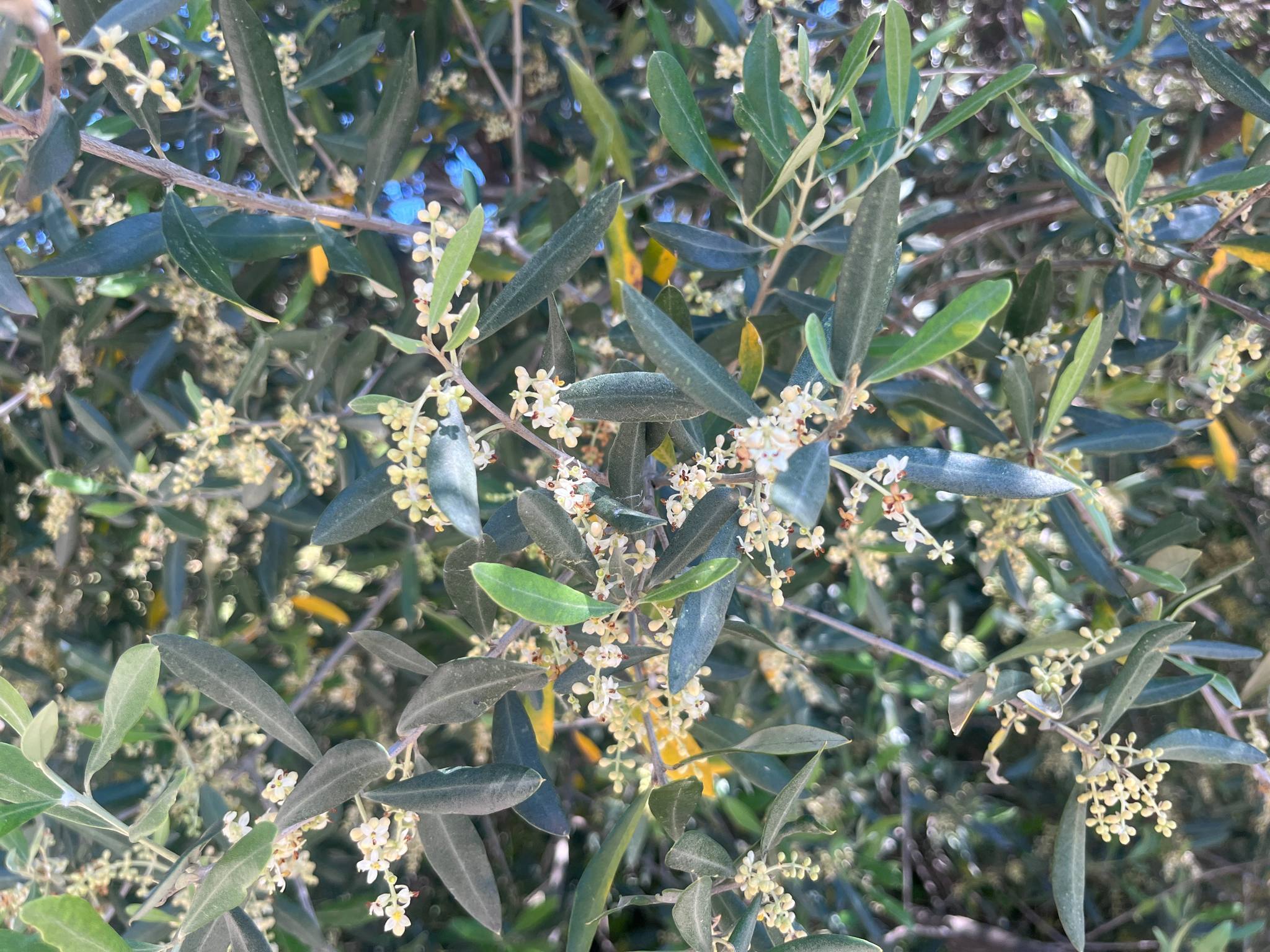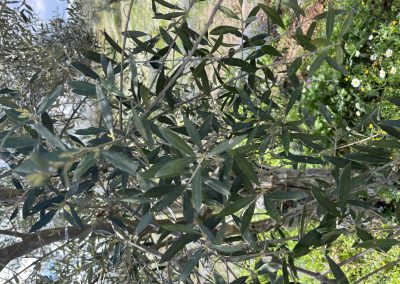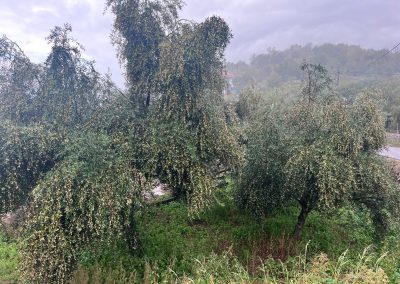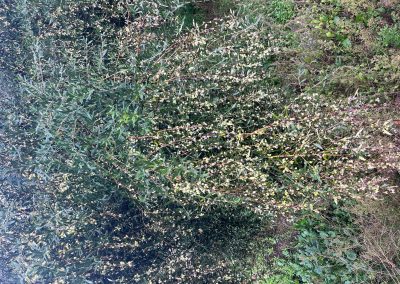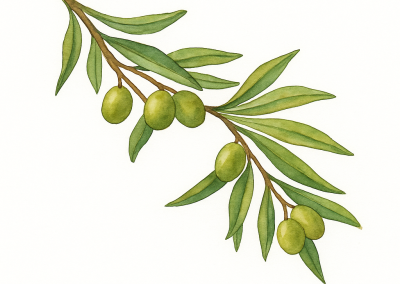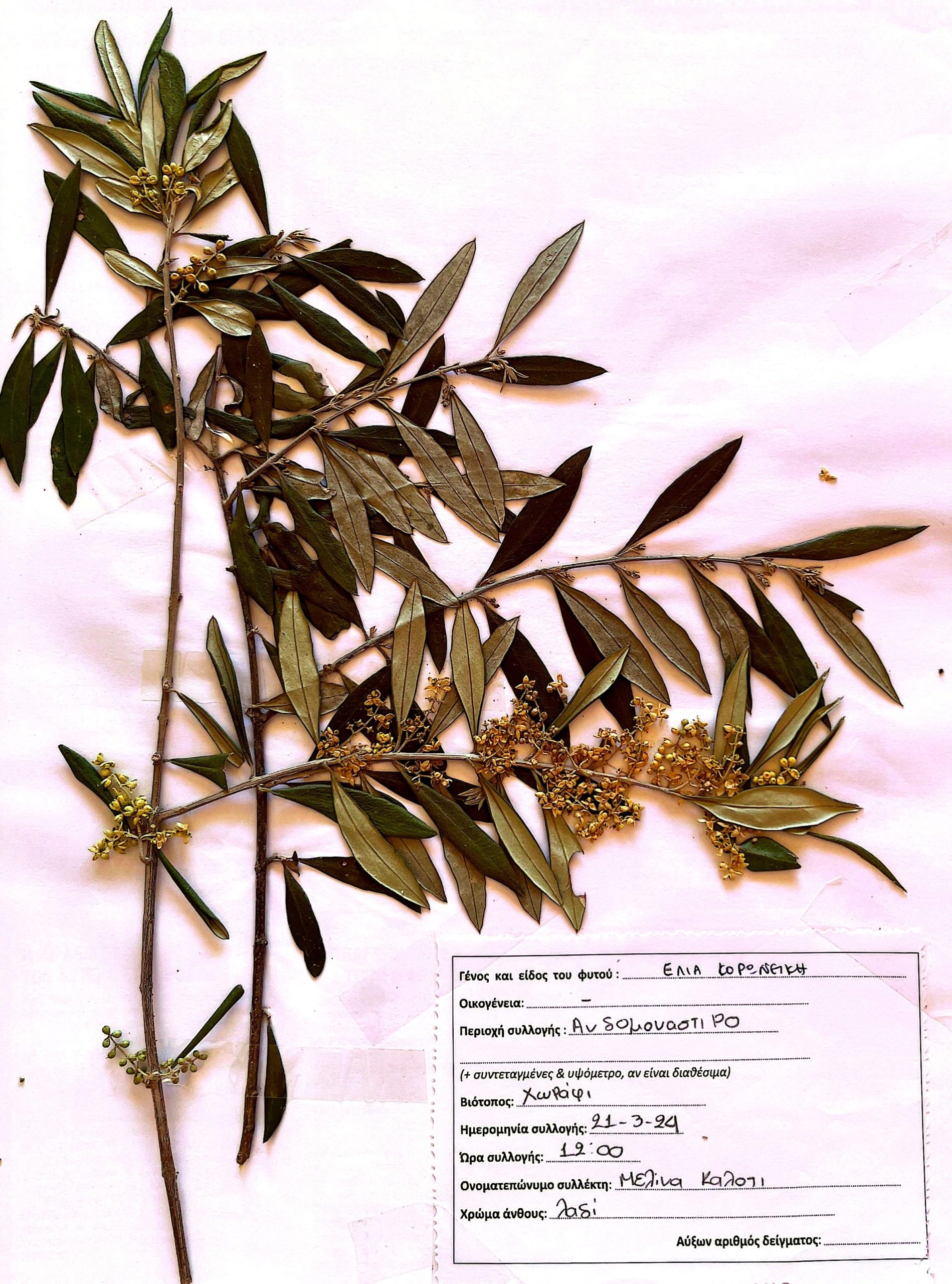Olea europaea ‘Koroneiki’
Scientific description
Scientific name: Olea europaea 'Koroneiki'
Kingdom: Plantae
Taxonomy: Magnoliophyta (Magnoliophyta), Dicotyledons (Magnoliopsida), Scrophulariales
Family: Oleaceae
Genus: Olea
Greek variety: Koroneiki
Greek common names: Psilolia, Lianolia, Vacikior, Korani
Origin:
Known since ancient times, probably from the eastern Mediterranean. Greek tradition says the olive is native to Athens, first planted by Athena on the Acropolis. Greeks were first to cultivate olives in European Mediterranean. Introduced by Greek colonists or Phoenician traders.
Description:
Perennial evergreen tree, up to 10 m. Hard, grooved trunk, small leathery silvery-green leaves, white-green flowers in late May, round or oval fruits green at first, black when ripe.
Trunk: Smooth and greenish when young; becomes thick, grey, wrinkled with bumps over years.
Shoots: Long (1.9–2.2 cm), short (1.3–1.7 cm), very short (0.8–1 cm).
Leaves: Narrow, lance-shaped, thin, opposite, cruciform pattern, deep green top, light grey bottom, upper surface with chitin, lower surface with umbrella-shaped hairs.
Flowers: White, inflorescences of 10–40 flowers, perfect and imperfect.
Fruit: Varies by variety; green → reddish-brown → black; hard core protects a single seed.
Propagation:
Asexual: cuttings, grafting, shoots. Sexual: via seeds.
Ecology:
Thrives in temperate climates without temperature extremes (average 16°C). Widespread in Mediterranean: Greece, Italy, Spain, Turkey, Algeria.
Use:
Essential in Mediterranean diet: table olives and olive oil.
Επιστημονική ονομασία: Olea europaea 'Koroneiki'
Βασίλειο: Φυτά (Plantae)
Συνομοταξία: Αγγειόσπερμα (Magnoliophyta)
Ομοταξία: Δικοτυλήδονα (Magnoliopsida)
Τάξη: Χοιραδιώδη (Scrophulariales)
Οικογένεια: Ελαιοειδή (Oleaceae)
Γένος: Ελαία (Olea)
Ποικιλία: Κορονέϊκη
Κοινά ονόματα: Psilolia, Lianolia, Vacikior, Korani
Καταγωγή:
Η ελιά είναι γνωστή από αρχαιότατους χρόνους, πιθανότατα από την ανατολική Μεσόγειο. Η ελληνική παράδοση λέει ότι η πρώτη ελιά φυτεύτηκε από την Αθηνά στην Ακρόπολη. Οι Έλληνες ήταν οι πρώτοι που καλλιέργησαν την ελιά στην Ευρωπαϊκή Μεσόγειο. Εισήχθη από Έλληνες αποίκους ή Φοίνικες εμπόρους.
Περιγραφή:
Αειθαλές δένδρο, έως 10 μ., σκληρός αυλακωτός κορμός, μικρά δερματώδη ασημοπράσινα φύλλα, άνθη ασπροπράσινα τέλος Μαΐου, καρποί στρογγυλοί/ωοειδείς πράσινοι στην αρχή, μαύροι όταν ωριμάσουν.
Κορμός: Λείος και πρασινωπός νεαρό δένδρο, παχύς και γκρίζος με ρυτίδες και γόγγρους με τα χρόνια.
Βλαστοί: Μακριοί 1,9–2,2 cm, κοντοί 1,3–1,7 cm, πολύ κοντοί 0,8–1 cm.
Φύλλα: Στενόμακρα, λογχοειδή, αντίθετα σε σταυροειδή διάταξη, πράσινα πάνω, γκρι κάτω, επιφάνεια επάνω με χυτίνη, κάτω με τρίχες ομπρέλας.
Άνθη: Λευκά, ταξιανθίες 10–40 άνθη, τέλεια και ατελή.
Καρπός: Διαφέρει ανά ποικιλία, πράσινος → καφεκόκκινος → μαύρος, σκληρός πυρήνας με έναν σπόρο.
Πολλαπλασιασμός:
Αγενής: γόγγροι, παραφυάδες, μοσχεύματα, εμβολιασμός. Εγενής: με σπόρους.
Οικολογία:
Ευδοκιμεί σε εύκρατα κλίματα, χωρίς ακραίες θερμοκρασίες (μέση 16°C), διαδεδομένη στη Μεσόγειο (Ελλάδα, Ιταλία, Ισπανία, Τουρκία, Αλγερία).
Χρήση:
Βασικός καρπός για Μεσογειακή διατροφή: επιτραπέζιες ελιές και ελαιόλαδο.
Nom scientifique: Olea europaea 'Koroneiki'
Royaume: Plantes (Plantae)
Taxonomie: Magnoliophyta (Magnoliophyta), Dicotylédones (Magnoliopsida), Scrophulariales
Famille: Oléacées
Genre: Olea
Variété grecque: Koroneiki
Noms communs: Psilolia, Lianolia, Vacikior, Korani
Origine:
Connu depuis l’Antiquité, probablement Méditerranée orientale. Selon la tradition grecque, premier olivier planté par Athéna à l’Acropole. Cultivé par les Grecs, introduit par colons grecs ou commerçants phéniciens.
Description:
Arbre persistant jusqu’à 10 m. Tronc dur et cannelé, petites feuilles coriaces vert argenté, fleurs blanc-vert fin mai, fruits ronds/ovales verts → noirs.
Tronc: Lisse et verdâtre jeune, épais, gris, ridé avec bosses en vieillissant.
Pousses: Longues 1,9–2,2 cm, courtes 1,3–1,7 cm, très courtes 0,8–1 cm.
Feuilles: Étroit, lancéolées, opposées, schéma cruciforme, vert foncé dessus, gris clair dessous, dessus chitine, dessous poils en parapluie.
Fleurs: Blanches, 10–40 fleurs par inflorescence, parfaites et imparfaites.
Fruit: Varie par variété; vert → brun-rouge → noir; noyau dur avec une graine.
Propagation:
Asexuée: boutures, greffes, pousses. Sexuée: par graines.
Écologie:
Climats tempérés, sans extrêmes (moyenne 16°C), répandu Méditerranée: Grèce, Italie, Espagne, Turquie, Algérie.
Utilisation:
Indispensable dans alimentation méditerranéenne: olives de table et huile d’olive.
Denumire științifică: Olea europaea 'Koroneiki'
Regn: Plantae
Taxonomie: Magnoliophyta (Magnoliophyta), Dicotyledons (Magnoliopsida), Scrophulariales
Familie: Oleaceae
Gen: Olea
Soi grecesc: Koroneiki
Denumiri comune: Psilolia, Lianolia, Vacikior, Korani
Origine:
Cunoscut din cele mai vechi timpuri, probabil din zona est-mediteraneană. Tradiția greacă spune că primul măslin a fost plantat de zeița Atena pe Acropole. Grecii au fost primii care l-au cultivat în Europa mediteraneană. Introducerea prin coloniști greci sau comercianți fenicieni.
Descriere:
Arbore veșnic verde, până la 10 m. Trunchi dur, canelat, frunze mici pieloase verde-argintiu, flori alb-verzui sfârșit mai, fructe rotunde/ovale verzi → negre.
Pom: Trunchi neted, verzui tânăr, gros, gri, ridat cu gonguri/globule.
Lăstari: Lung 1,9–2,2 cm, scurt 1,3–1,7 cm, foarte scurt 0,8–1 cm.
Frunze: Înguste, lanceolate, subțiri, opuse în model cruciform, verde închis sus, gri jos, suprafața superioară chitinoasă, inferioară cu peri în formă de umbrelă.
Flori: Albe, 10–40 flori/ciorchine, perfecte și imperfecte.
Fruct: Variează după soi, verde → roșu-brun → negru, miez dur cu o sămânță.
Înmulțire:
Asexuat: ganglioni, lăstari globulari, butași, altoire. Sexuat: cu sâmburi.
Ecologie:
Climate temperate fără extreme, medie anuală 16°C, răspândit în zona mediteraneană (Grecia, Italia, Spania, Turcia, Algeria).
Utilizare:
Esențial pentru dieta mediteraneană: măsline comestibile și ulei de măsline.
Creative writing inspired by Olea europaea ‘Koroneiki’
Olea europaea 'Koroneiki'
In a small mountain village of ancient Messinia called Koroni, the inhabitants were known for their devotion to the goddess Athena, protector of wisdom and the olive tree. Every year, they held a grand contest in her honor, where young men and women competed to find and bring back the finest, most fruitful olive tree from the surrounding hills.
One year, a young woman named Cleoniki, known for her wisdom and humility, entered the competition. Unlike the other contestants, who searched in the fertile lowlands and lush groves, Cleoniki decided to climb the steep mountains. There, among the rugged rocks, she discovered a small but resilient olive tree, with slender leaves and tiny fruit.
Though its fruit was small, the tree produced the most fragrant and richly flavored olive oil anyone had ever tasted. When Cleoniki brought her tree to the contest, the others mocked her for its humble appearance. However, when the time came to taste its oil, everyone was astonished by its exceptional quality.
The goddess Athena, observing Cleoniki’s wisdom and humility, appeared and blessed the olive tree, declaring that it would become the most noble variety of olive and would produce oil of unique flavor and strength. She named the olive tree "Koroneiki," in honor of the place it was found and of Cleoniki, who had shown great foresight and understanding.
From that time on, the Koroneiki olive became a symbol of resilience and blessing, known for producing the finest olive oil. It remains a treasure of the Greek land, cultivated in the sacred olive groves of Greece with the same care and respect as in ancient times.


